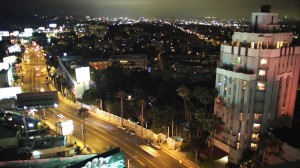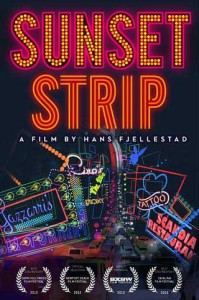
Documentary films are often more complex in the finishing process than features. The documentary structure is unique in that the story is told by using all types of source material. This poses an added challenge for the colorist in that it requires the color to match and balance with both recent and archival footage.
In Sunset Strip, interviews were shot at various venues with a change in production crew at each location. This gave every interview a very different look and style due to the changes in lighting and camera setups.
In order to give the film its overall intended look, AlphaDogs editor and colorist, Sean Stack was careful to keep the detail in the foreground and without oversaturating, added brightness and balance to the skin tones of the interviewees, making them the primary focus as they tell the story of Sunset Strip in their own words.
One very iconic interview setup that underlines the storytelling method includes two people being interviewed parked outside a nightclub sitting on their Harley-Davidson motorcycles. “Another brilliant creative choice made by director Fjellestad,” said Stack. “When it came to the interviews, the idea of having more than one participant in the interview sessions made for lively and spontaneous exchanges that otherwise might not have happened.”
 The Sunset Strip concert and club footage features plenty of handheld camera work shot guerrilla style. Color grading challenges are often prevalent in these types of low lighting conditions. Stack took direction from Fjellestad in maintaining the detail in the shadows as much as possible, while working together in scrutinizing specific scenes preventing nuances of the performances from becoming lost in the darker parts of the image.
The Sunset Strip concert and club footage features plenty of handheld camera work shot guerrilla style. Color grading challenges are often prevalent in these types of low lighting conditions. Stack took direction from Fjellestad in maintaining the detail in the shadows as much as possible, while working together in scrutinizing specific scenes preventing nuances of the performances from becoming lost in the darker parts of the image.
The color grading focused on producing a seamless club experience within a venue by enhancing the emotion of the performances along with reactions from the fans. Although a time-consuming process, Stack used external video scopes to monitor the adjustments in order to accurately add detail to the shadow areas, increase brightness where needed, and keep color saturation within legal broadcast range.
“This underscores the importance of allowing ample time for color grading and basic corrections as well,” explained Stack. “It’s imperative that you don’t rush through and miss the crucial details. Despite the tight deadline, it’s often worth the effort for a good-looking film that also passes QC.”
Audio on documentaries can also bring distinctive challenges because they are not shot in a traditional Hollywood production environment. Sound space can differ dramatically between scenes, and the slightest background ambiance can make smooth sound transitions quite difficult. In Sunset Strip, extensive amounts of interview footage that was cut to 15 seconds or less proved particularly challenging.
AlphaDogs audio mixer Curtis Fritsch began by removing distracting background noises using plug-ins designed to isolate and remove troublesome noise. Quick fades and room tones were then added to smooth out the sound quality. “This was a tricky thing to do with so many people being interviewed,” said Fritsch. “In some cases I had to steal syllables from another word to make the dialogue sound better.”
The 5.1 surround sound mix needed to be close as possible to the original stereo mix. Fritsch worked diligently on redesigning a total of 10 isolated tracks from some of the concert footage.
“Sunset Strip was a fun opportunity in designing the placement and volume of instruments along with the vocals,” said Fritsch. “A stereo mix in 5.1 is pretty straight forward, but when you have 10 tracks to mix, it becomes more of a creative process in enhancing the sound without making it sound like a different recording.”
Under the demanding deadline of less than one week, the documentary was delivered on time and within budget. “This was an ambitious project on so many levels and when it came time to deliver to Showtime, Sean and Curtis really helped us pull it all together in a crazy short period of time,” said Fjellestad. “But even under the gun, they never lost focus on the creative aspects of the film.”





